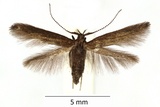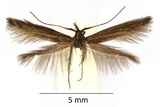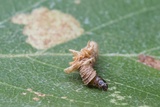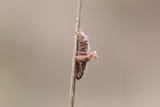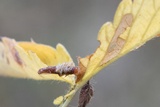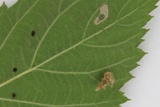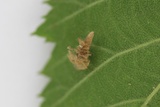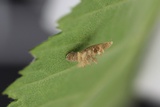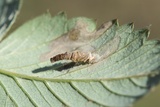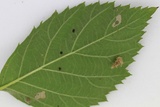Coleophora potentillae Elisha, 1885 Species
Last modified: Nov. 28, 2025, 1:36 p.m.
A not so common species in Belgium. The first observation was in 1981 at Mol-Balen (AN). Most of the time difficult to find.
Details
- Classification
- Family: Coleophoridae > Genus: Coleophora > Species: Coleophora potentillae
- Vernacular names
- Braamkokermot (NL), Shaded case-bearer (EN), Brombeer-Sackmotte (DE)
- Synonyms
- Coleophora bothnicella Kanerva, 1941
- First mention in Belgium
- Coenen F., De Prins W. & Henderickx H. 1984. Coleophora potentillae Elisha, een nieuwe soort voor de Belgische fauna (Lepidoptera: Coleophoridae). — Phegea 12: 61–66. On page 61 (as Coleophora potentillae Elisha). view page
- Status
-
Native
Distribution
Case
The youth case is quite different from the full-grown case, consisting of many small rings, and having a mouth angle of about 90°. Later on, the caterpillar lives in a lobe case.
The mouth angle is 30°–50°.
See also bladmineerders.be.
Bionomics
The eggs are deposited on the underside of a leaf.
The youth cases are eating after the winter again.
The lobes from adult larvae are cut out from the underside of a leaf (Compare with Coleophora violacea, that cuts the lobes from the upperside of the leaf.)
The adult larvae are fully grown in the autumn.
Adult larvae are wandering around also a lot, reaching so many different plants and tree leaves...giving rather a lot of misidentification of host plants.
Pupation in the case, usually attached to a trunk in the neighbourhood of the food plant.
The adults come to light.
Flight periods
The adults fly in one generation a year, occurring from mid-June till the beginning of August.
Observed on
- Host plant (species):
- Rubus fruticosus
- Host plant (genera):
- Rubus, Fragaria, Potentilla, Spiraea, Sanguisorba, Agrimonia, Rosa, Filipendula, Betula, Salix, Prunus and Malus
- Substrates:
- Polyphagous
The larvae are very polyphagous, but mostly on Rubus fruticosus.
